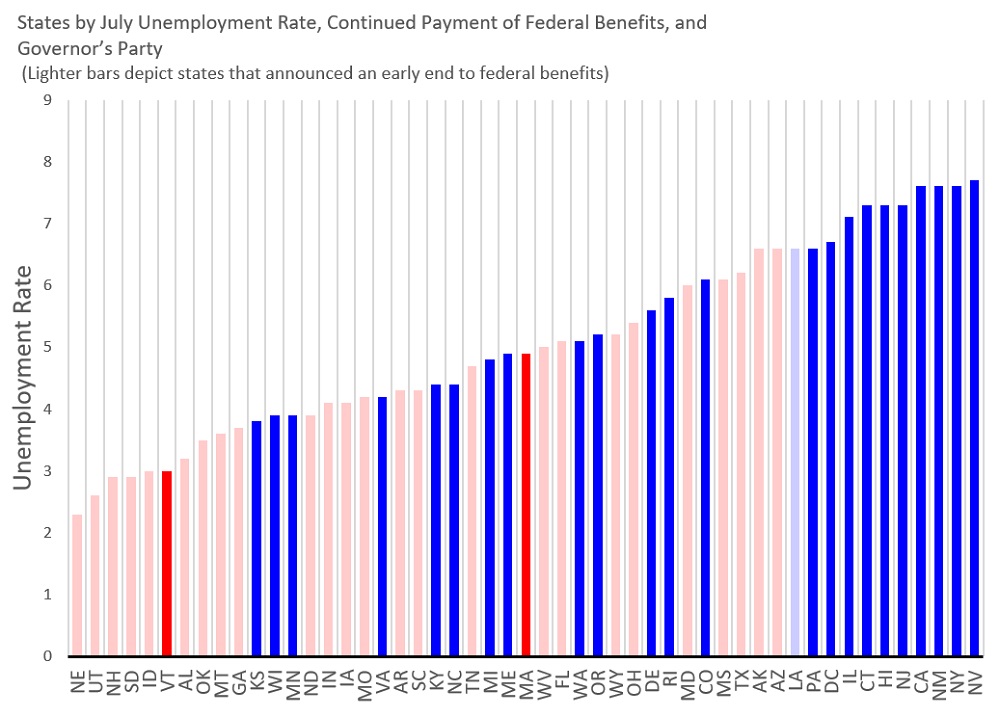The Biden administration and congressional Democrats designed the largest benefits cliff in US history and then tried to change the subject as over 7 million unemployment recipients saw federal benefits abruptly end on Labor Day. Meanwhile the administration quietly offered the blue states hit the hardest an opportunity to continue payments to their residents using previously provided federal funds. But “No state has said it plans to do so,” according to the New York Times. Why?
Some background is needed. In normal times, states collect around $30 billion in annual payroll taxes to support state unemployment benefits, which typically last up to 26 weeks per recipient. Before the pandemic, about 2 million people collected state unemployment checks.
The past 18 months have been anything but normal. First, the pandemic struck, and then Congress responded with an unprecedented package of temporary federal unemployment benefits. As is typical in recessions, this included extended benefits for those exhausting state checks. But it also included a first-ever federal program called Pandemic Unemployment Assistance, which soon became the nation’s largest unemployment benefit provider due in no small part to easy eligibility criteria, generous benefits, and unprecedented fraud. Congress also increased every unemployment check by $600 per week (and, more recently, by $300 per week) in an unprecedented move initially designed to “make whole” workers laid off due to pandemic shutdowns.
That resulted in most early recipients collecting more in unemployment benefits than paychecks. In all, state and federal benefit spending soared by over $800 billion. Checks eventually peaked at over 30 million recipients per week, before declining as state economies reopened. Several extensions continued these temporary federal benefits through Labor Day.
But over the summer, another unprecedented event occurred — states simply opted out of paying the temporary federal benefits. Eventually half of all states opted out — mostly red states, with the exception of Louisiana, led by Democrat John Bel Edwards, who said he was “trying to find a ‘reasonable balance’ between helping the jobless and assisting businesses that say they’re having trouble finding people to fill their employee ranks.”
As the chart below displays, that left federal benefits payable in mostly blue states — which ultimately hit the Labor Day cliff when those benefits abruptly expired:

Sources: Department of Labor and Congressional Research Service.
An August 19 letter authored by Treasury Secretary Yellen and Labor Secretary Walsh offered those mostly blue states a path to keep benefits flowing:
The American Rescue Plan allocated $350 billion to state and local governments to support communities’ continuing response to the pandemic. . . . Now, in states where a more gradual wind down of income support for unemployed workers makes sense based on local economic conditions, American Rescue Plan funds can be activated to cover the cost of providing assistance to unemployed workers beyond September 6th.
Which brings us back to our initial question. If the administration thinks it “makes sense” for high-unemployment blue states to continue paying these benefits, why have none chosen to do so? There are several likely reasons.
First, the $350 billion in federal funds provided states in March may already be spoken for, if not fully spent. For example, New York quickly used some of those funds to provide new unemployment benefits to undocumented workers. Other states have similarly announced plans to spend these funds on local priorities.
Second, without new federal funds, the Biden administration’s offer entails only higher state costs. Not only would the cost of administering such expanded benefits fall on states, but their continued availability would further drive up claims for state benefits and ultimately state payroll taxes, as the Congressional Budget Office has noted.
Third, any states offering such benefits today would be pressed to repeat such expansions whenever temporary federal benefits expire in the future. States have long shown reluctance to pay for such expanded benefits. For example, following the Great Recession, 28 states — including large blue states like California, Illinois, New York, and Pennsylvania — adopted eligibility criteria that ended some benefit payments as soon as full federal funding expired and the state was expected to cover half of the cost. Why would states now create a precedent of paying for such benefits when the entire cost might fall on them?
In the end, it’s no surprise that even blue states rejected the Biden administration’s offer to continue providing unprecedented benefits after dedicated federal funding for them expired. The only real surprise would be if the administration actually believed that some might.





